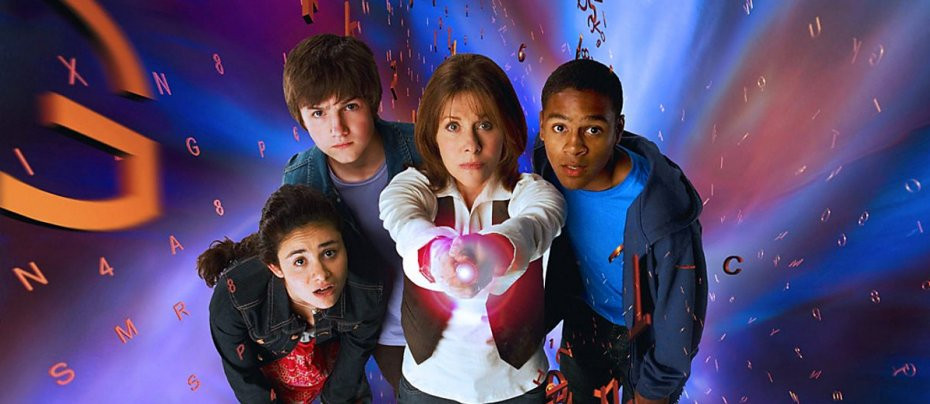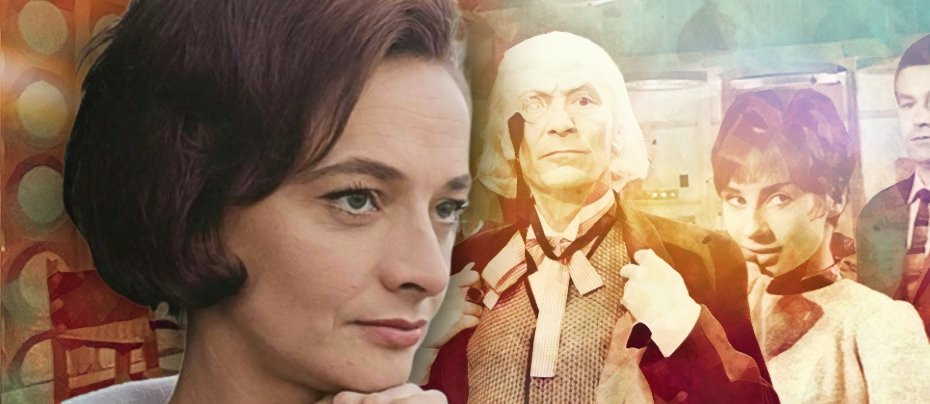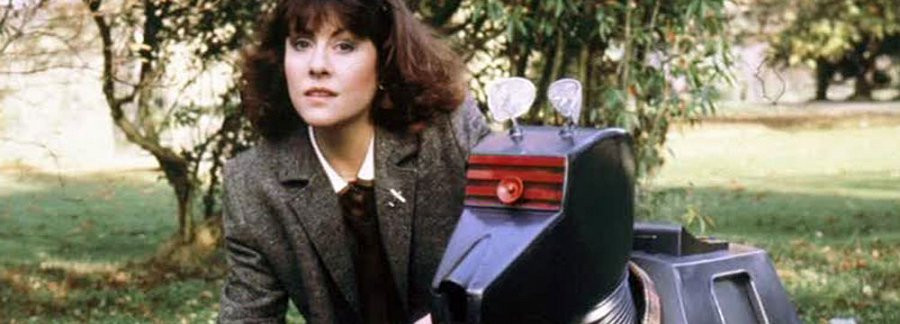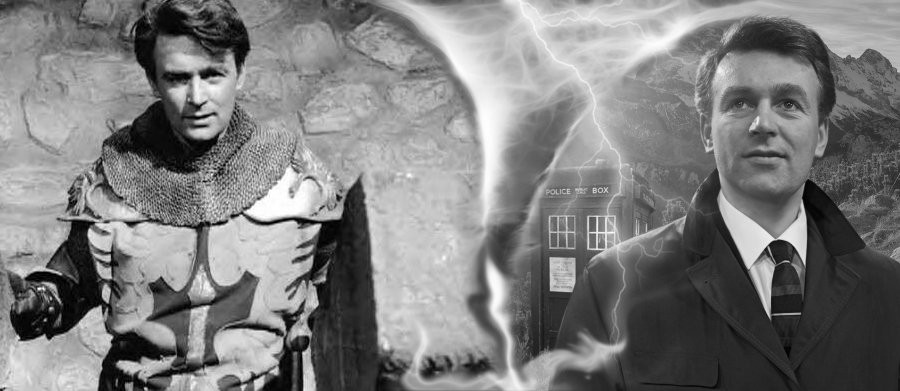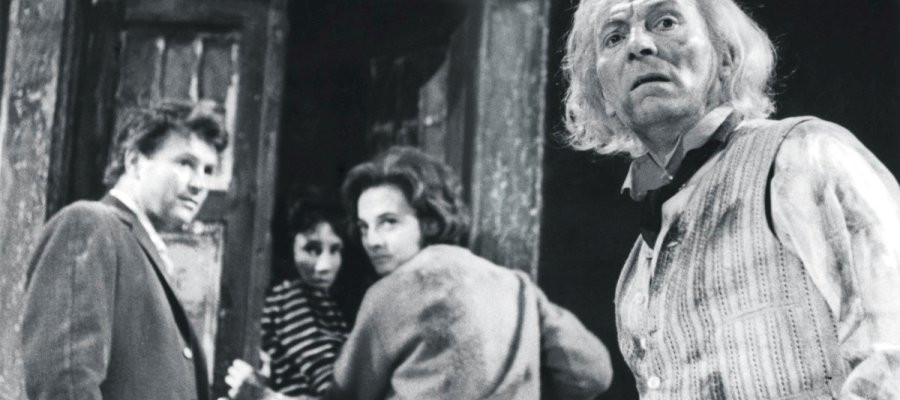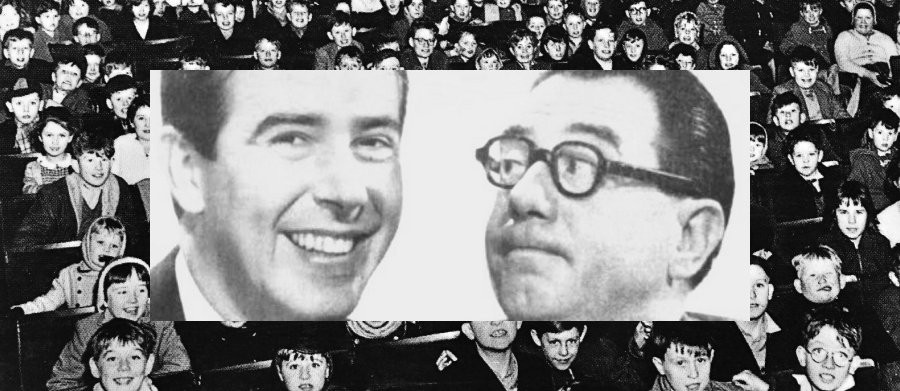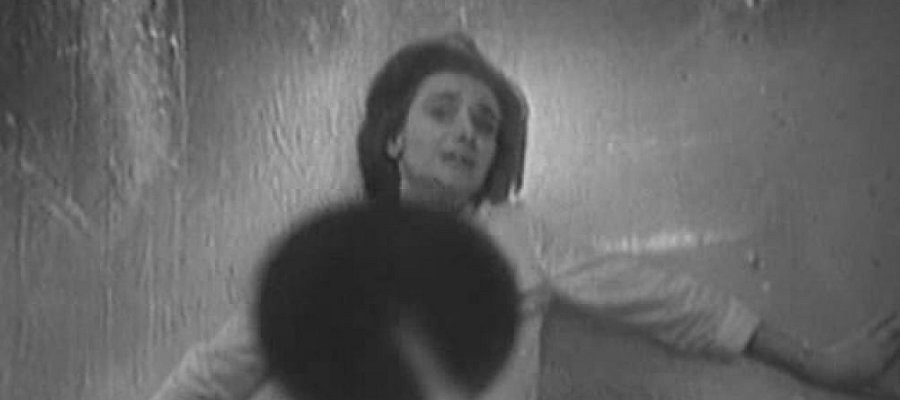The Sensorites

This is not a comprehensive blow-by-blow, every scene review of the Doctor Who story The Sensorites, but it does contain major plot outlines and spoilers.
“It all started out as a mild curiosity in a junkyard, and now it’s turned out to be quite a great spirit of adventure.”
These words, spoken by the enigmatic First Doctor, set the stage for the traveller’s latest journey into the unknown.
The first episode of The Sensorites begins with a mystery on board the TARDIS. The ship appears to have landed somewhere but the console instruments indicate that it is still moving. With the scanner covered with static and unable to view the exterior area, the Doctor takes the decision to venture outside. The travellers find they have landed on a drifting spaceship, and its crew, a male and a female, seated at the spaceship's instrument panels, are dead. The corpses are wearing self-winding watches, which are powered by the movement of the wrist, but they have stopped, indicating that death must have occurred at least twenty-four hours ago. And yet, their bodies are warm.

As the travellers are about to leave, the male crew member slumps forward and makes a sound. He's alive but struggling to breathe. At the man’s request, Ian retrieves a small device from a shelf behind him and the man uses it to fully revive himself. The device is then placed against the female crew member's chest. She too is revived.
Maitland, the ship’s captain, explains that the device is a heart resuscitator. Alongside him is Carol Richmond, the female crew member. They inform the travellers that they are on an exploration mission from Earth in the 28th century, currently orbiting Sense-Sphere. The Sensorites, the planet’s inhabitants, adamantly prevent them from leaving orbit. Not only do they have control over the spacecraft, but they also manipulate the minds of any nearby humans. Despite their apparent hostility, the Sensorites refrain from harming the crew. Instead, they induce a near-death slumber, occasionally visiting to provide sustenance.
As they are discussing the crew's predicament they smell burning, but do not notice a mysterious figure removing the lock out of the TARDIS doors. The Sensorites have deliberately locked the travellers out of their ship, so they too are permanently trapped like Maitland and Richmond. At this point, The Sensorites take control of the Earth ship, sending it on a collision course with the Sense-Sphere. The Doctor manages to divert the course and steady the craft. The Doctor is told that the only person who has actually seen the Sensorites is another crew member, John, the ship's mineralogist. Whilst looking through the craft, Barbara and Susan encounter this crew member who Maitland and Richmond seem reluctant to talk about.

John, moving with a zombie-like gait, shuffles toward the terrified women. But just as he corners them, he crumples to the ground, tears streaming down his face. The man is clearly terrified. In the meantime, the remaining crew members become aware that Barbara and Susan are trapped in another section of the craft, behind a sealed door, with John. Maitland swiftly wields a cutting device to free them. As the blade slices through the obstruction, Maitland’s ears catch a sound—a Sensorite ship is drawing near. Ian’s astonishment peaks as he spots a Sensorite, seemingly in space, standing just outside the craft and visible through the viewing port.

At the window, the Sensorite renders the two crew members paralyzed. The Doctor successfully rouses Maitland from his trance, allowing him to continue his efforts to free Susan and Barbara. Inside the locked area, John—still distressed—maintains near-constant telepathic communication with the Sensorites. These extraterrestrial beings attempt to manipulate him into frightening away the travellers. Barbara and Susan, determined, focus on the phrase, “We defy you,” causing the Sensorites to collapse to the floor. Ian and the rest of the crew open the door, releasing Barbara, Susan, and the now unconscious John. As Ian tends to John, the latter utters the cryptic phrase “the dreams of avarice.”
Ian speculates that John has uncovered valuable information about the Sense-Sphere that would prove valuable to the human race, leading to their vessel’s entrapment. The Doctor discovers that the Sense-Sphere harbours a wealth of molybdenum, a precious material. The Sensorites talk to Susan telepathically through the door, asking for a face-to-face conversation with the travellers, which they are granted. The Sensorites reveal that they have designated an area on the Sense-Sphere for human habitation—but with a strict prohibition against leaving. Undeterred, the Doctor boldly declares that he will not make his home on the Sensorites’ world.
In search of an advantage, the Doctor astutely observes that the Sensorites’ eyes significantly dilate in bright light. This vulnerability implies that they would be nearly blind in low-light conditions. The Sensorites reach out to Susan once more, and she seemingly consents to a proposition. She informs the Doctor that she has agreed to reside on the Sense-Sphere alongside the Sensorites, lest they execute all the humans. Two Sensorites escort Susan away, and the control room door closes behind them.

The Doctor and his companions refuse to allow Susan to simply leave. They chase after her and the Sensorites, demanding her return. However, the Sensorites insist that they require a hostage to safeguard their planet. Susan, motivated by the desire to save her friends’ lives, agrees with the Sensorites.
On the surface of the Sense-Sphere, three Sensorites engage in conversation. The Elder Sensorite acknowledges the risk he is taking by inviting the humans into his palace. His gamble will pay off if the Doctor can cure a disease that has afflicted all Sensorites for many years. In contrast, the other two Sensorites display disdain for the human race. While they act subservient in the Elder’s presence, their loyalty wavers once he departs. The most outspoken Sensorite in this dissent is the Administrator. He openly expresses distrust toward the humans and plots an uprising against the Elder’s leadership.
Among the Sensorites, the Elders are distinguished by wearing two sashes, while other controllers wear only one. The general populace is content without any sash. Curious about the difference, the Doctor enquires about social hierarchy. The Elder explains that the higher one ascends, the better the quality of life, including access to superior food and drink. Meanwhile, during this conversation, Ian experiences sudden coughing and choking. When questioned, he reveals that his throat feels like it’s burning up and requests water. Moments later, he collapses to the floor, unconscious. The Elder grimly informs the Doctor that this is the initial symptom of the illness, and Ian’s condition will prove fatal.
Suspecting that the water Ian drank was contaminated, the Doctor begins to doubt that the ailment the Sensorites describe is truly a disease—it appears more like poison. The Administrator, however, accuses the Doctor of malevolence, suggesting that he aims to gain the Sensorites’ trust only to betray them. The Administrator proposes that by disguising himself as an Elder (simply by donning an additional sash), he could seize control.

Meanwhile, the Doctor collaborates with Sensorite scientists and discovers that there are ten distinct water sources or districts. He requests samples from each location for testing. District Eight yields traces of atropine. Armed with this information, the Doctor prepares an antidote.
Simultaneously, the Administrator takes drastic action: he kidnaps an Elder and the Elder’s family. Brandishing the sash, he intends to prove to the Elder that the Doctor harbours evil intentions and has no genuine desire to assist them. According to the Administrator, the antidote concocted by the Doctor is actually a poison. He believes that Ian has been feigning illness and will pretend to recover. The poison, then, will be administered to the Sensorites, effectively wiping them out and leaving the humans to exploit the Sense-Sphere.
The Administrator’s plan gains traction when he encounters a scientist who mistakes him for an Elder. Instructing the scientist to hand over the antidote for Ian, the Administrator waits until the scientist is out of sight before shattering the test tube on the floor. The outcome hangs in the balance: if Ian improves, the Doctor’s honesty will be exposed; if he succumbs, the Doctor’s truthfulness will prevail.

Guided by a scientist, the Doctor ventures to the aqueduct in pursuit of the poison’s origin. The scientist, wary of the darkness, explains that their attempts to illuminate the area have consistently failed. When the Doctor announces his intention to enter the aqueduct, the scientist hesitates, issuing a grave warning: monstrous entities dwell within. Curious, the Doctor inquires whether anyone has ever laid eyes on these creatures. The scientist replies that they have only heard their fearsome roars. Undeterred, the Doctor dismisses the caution but muses on the convenient convergence of darkness and noise—the very conditions that the Sensorites find intolerable.
Deep within the shadowed aqueduct, the Doctor stumbles upon what he had suspected all along: Deadly Nightshade. But as this revelation dawns, a bone-chilling roar reverberates through the tunnel. The Doctor’s gaze shoots upward, locking onto an unseen figure. Ian and Susan, alerted by the sound, rush toward their companion. They discover the Doctor sprawled on the floor, his jacket torn but otherwise unharmed. Once outside the aqueduct, the Doctor shares his theory: a treacherous Sensorite is orchestrating their downfall, and the beast lurking in the waterway poisons their supply. Unfortunately, their conversation has not gone unnoticed—a loyal Sensorite spy reports to the Administrator. The Administrator, in turn, orders the Second Elder to retrieve ‘the disintegrator key’ from the Chief Warrior— to use a weapon for the humans’ demise.

Meanwhile, the Doctor, Ian, and Susan return to the palace, only to encounter the Administrator masquerading as an Elder. Back in the disintegrator room, the Administrator begins assembling the deadly weapon. But the Second Elder intervenes, overpowering the Sensorite helper and seizing the key. In a swift motion, the helper clubs the Second Elder to death. To disguise their murderous act the Administrator and his helper hatch a desperate plan to frame the Doctor and his companions. The helper falsely accuses the Doctor of murdering the other Second Elder, but Ian catches him in a lie—one that ultimately vindicates the Doctor.
The Doctor stumbles upon an ancient aqueduct map, which he promptly employs for yet another expedition. John, now fully recovered, recalls a peculiar detail about the treacherous Sensorite: the distinctive collar he wore. Determined, the Doctor and Ian set off for the aqueduct. As they advance, a mysterious movement catches their attention. Ian cautiously inches forward to investigate, only to be attacked by a human assailant. A brief scuffle ensues, and the man manages to escape, leaving behind a badge shaped like a rocket ship. The Doctor and Ian give chase, but soon find themselves surrounded by more humans. These survivors, they learn, were part of the initial expedition to the Sense-Sphere. The ship that crashed years ago belonged to deserting militia members. The commander, having blown up the ship before their escape, now leads a group bent on poisoning the Sensorites and claiming their planet. In his eyes, they are at war. Just then, another man enters, reporting additional arrivals. The commander, enraged and suspicious of the Doctor, accuses him of deception. When Barbara and John appear, the Doctor skilfully convinces the men that they are celebrating a triumphant human victory. Together, they head toward the aqueduct’s exit. Barbara covertly contacts the Sensorites, positioning them at the mouth of the aqueduct with weapons drawn to apprehend the humans.

Later, at the palace, the First Elder grants permission for Maitland to return the astronauts to Earth for medical care. Meanwhile, the Administrator faces exile to the outer wastes of the Sense-Sphere as punishment for his crimes. The TARDIS lock has been replaced, and the travellers are finally free to depart.
The first two episodes of The Sensorites are a masterclass in suspense. The Sensorites’ telepathic abilities create an eerie atmosphere, leaving us questioning their motives and hidden agendas. Their bulbous heads, dilated eyes, and white whiskers add to the otherworldly intrigue. As the Doctor investigates, we uncover their fear of humans and their desperate defence mechanisms. The stakes are high, and the tension builds as we wonder: What secrets lie within the Sensorites minds?
Alas, our journey takes an unexpected turn. The next three episodes seem to meander through corridors, both literal and metaphorical. The plot thickens, but not necessarily in a good way. We encounter subplots, diversions, and repetitive scenes that stretch the narrative thin. The Sensorites’ political struggles, internal conflicts, and bureaucratic debates become tiresome. It’s as if we’re stuck in a telepathic quagmire, desperately seeking escape. The tension dissipates, replaced by a sense of padding – a filler that detracts from the core mystery.
Here lies the crux of the matter: The Sensorites could have been a tighter, more impactful adventure. The story’s central premise – the clash between humans and Sensorites – deserved a leaner treatment. Had it been condensed to four or five episodes, we might have savoured every revelation, every twist, without the narrative flab. Imagine the suspense maintained, the stakes heightened, and the character development focused. Alas, the padding diluted the impact, leaving us yearning for brevity and depth.

In the early episodes, Susan demonstrates an affinity for telepathic communication with the Sensorites—a character trait that had been promised to actress Carole Ann Ford when she was first cast in the role of Susan. However, this intriguing aspect remains largely undeveloped. Instead, Susan’s independence gradually emerges, foreshadowing her eventual departure from the show—a decision made by Ford herself. Unfortunately, as the plot unfolds, Susan’s centrality diminishes, and the Sensorites’ initial fear of humans, along with their formidable defence mechanisms, becomes squandered. Their telepathic powers, once terrifying as they could paralyze, manipulate, and reduce humans to gibbering wrecks, seem to fade into oblivion in later episodes.

Instead of delving into the aliens’ psychological nuances, writer Peter R. Newman employs the Sensorites’ rigid social hierarchy to reflect on the division of people based on their skills and contributions to society. While elements like political intrigue, a courtroom-style confrontation, and a disease scare aim to add depth, they ultimately fall short in several crucial aspects.
The Sensorites remains a mixed bag. Its opening promises intrigue, but the subsequent padding dampens the experience. Yet, it’s a testament to the show’s resilience that sixty years later we are still discussing it and able to rewatch it on BBC iPlayer – even flawed adventures contribute to the rich tapestry of Doctor Who. We forgive the lows and embrace the telepathic odyssey that is The Sensorites. Perhaps, in the vastness of time and space, even padding has its purpose.


